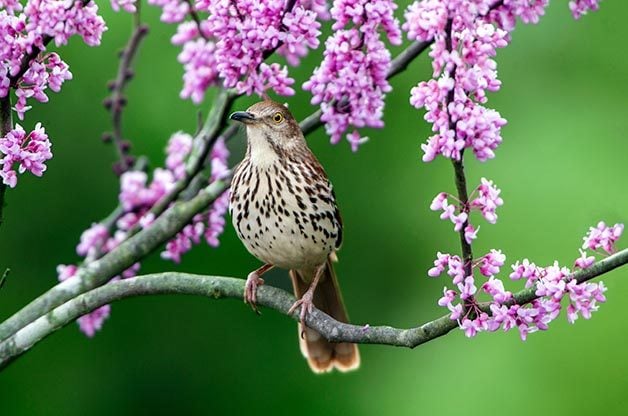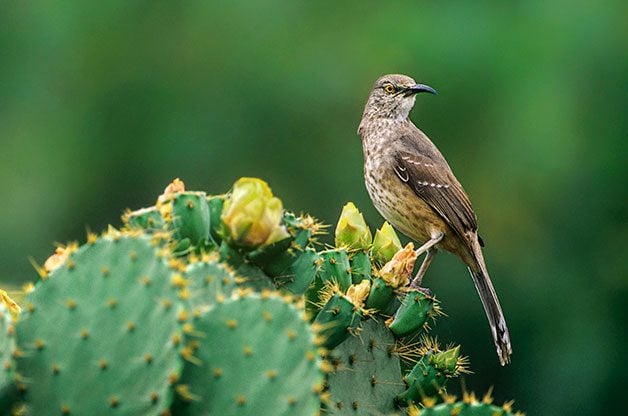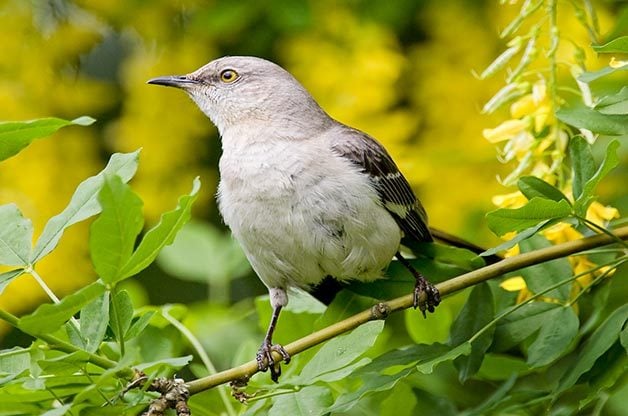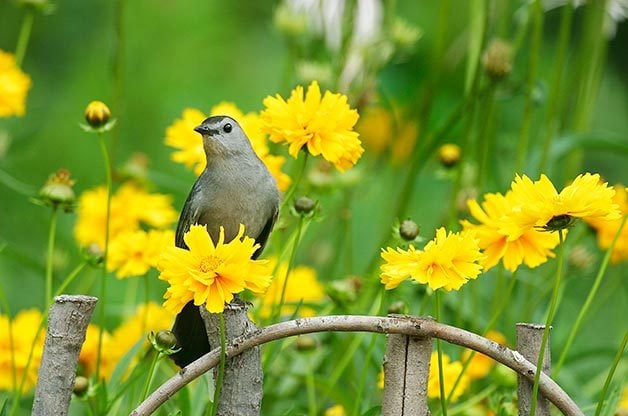Mimic Birds and Mimicry: Three Species to Know
Updated: Apr. 09, 2024
Tune in to the copycat songs of mimic birds, like mockingbirds, catbirds and thrashers. Plus, how to attract mimic birds to your backyard!

Bird that mimic other birds are the cover artists of the bird world, borrowing tunes from other birds to use as their own. Some mimicry species—mockingbirds, thrashers and catbirds—may sing more than a hundred different phrases. These slim birds all have distinctive long tails and usually have plumage in earthy tones, like gray and brown. Here’s everything you need to know about locating and attracting mimic birds.
On This Page
Thrashers

Types of Thrasher Birds to Know
The U.S. Southwest, Mexico and the Caribbean islands are thrasher hot spots. The curve-billed is the most common in the Southwestern states, while a look-alike species, Bendire’s thrasher, has a more restricted range centered on Arizona and western Mexico. The California thrasher prefers the brushy chaparral hills of its namesake state, while the sage thrasher is found in the western flats from southern Canada to northern Mexico.
Most have long down-curved bills, although the two most widespread, the brown and the sage thrashers, have straighter bills.
Behind the Music
The brown thrasher stands out because it usually repeats each phrase twice. Other mimics will repeat things, but consistently doing them twice is a brown thrasher specialty. (Read more: Top Songbirds in America)
Attract Thrashers to Your Yard
Entice thrashers into your backyard with thick cover. To do this, build a brush pile and sprinkle some seeds nearby. Thrashers usually scamper across the ground, flinging leaf litter in search of invertebrate snacks. Grow a thick hedgerow of native shrubs to provide good shelter for numerous critters.
Thrashes love fruits and berries, too. Juniper, sage, mesquite and chaparral shrub are favorite haunts for thrashers in the West, and curve-billed thrashers particularly love cholla cactus, which is their preferred nesting site.
Mockingbirds

Types of Mockingbirds to Know
Northern mockingbirds are found in parks and backyards throughout the southern and central United States, but they’ve been known to wander northward, even as far north as the Bering Sea region of Alaska. They’re the only mockingbird regularly found in the United States, but 13 species live throughout Central and South America.
A handful of species are on the Galapagos Islands, observations of which helped shape Charles Darwin’s thoughts on evolution.
Behind the Music
Thanks to their incessant singing, northern mockingbirds are quite conspicuous. Their song is a series of short phrases repeated over and over, usually in sets of three or more. New phrases, as many as 200, are added to their repertoire throughout their lifetimes.
Their scientific name, Mimus polyglottos, translates to “mimic with many tongues.” This species mimics not only other birds but also noises like cellphones, car alarms and the whistles of passing trains.
Attract Mockingbirds to Your Yard
Encourage mockingbirds with perches and suet feeders. Sometimes mockingbirds flash their white wing patches, either as a display or as a way to startle up one of their favorite summer treats: insects. During fall and winter, mockingbirds camp out in fruit trees gorging on the ripe harvests, but any fruits and berries can be offered in feeders year-round.
Catbirds

Types of Catbirds to Know
While the gray catbird is absent from the Southwest and much of the West Coast, it’s widespread throughout the rest of the country. Several unrelated species of catbirds are found in the world, like the green catbird of Australia and the white-eared catbird of New Guinea, but none of the others is a mimic like the gray catbird.
Behind the Music
Although they have well-defined rictal bristles (the bird version of whiskers), gray catbirds are actually named after their meowing callnotes. Catbirds often meow from thick cover, but they venture out into open areas, especially to feed. The least accomplished of mimic birds, they typically sing a series of disjointed notes, squeaks and whines.
Catbirds don’t often repeat phrases, either. However, individuals do add phrases they’ve picked up from birds, other animals or manmade sound sources, inserting them around the catbird gibberish.
Attract Catbirds to Your Yard
Gray catbirds are suckers for sweets, and they love backyard fruit feeders that include orange slices and grape jelly. Like thrashers, catbirds use brush piles, but another favorite is thickets of dogwood. These shrubs provide good cover, and the berries are an excellent meal.
Why Trust Us
For nearly 30 years, Birds & Blooms, a Trusted Media Brand, has been inspiring readers to have a lifelong love of birding, gardening and nature. We are the #1 bird and garden magazine in North America and a trusted online resource for over 15 million outdoor enthusiasts annually. Our library of thousands of informative articles and how-tos has been written by trusted journalists and fact-checked by bird and garden experts for accuracy. In addition to our staff of experienced gardeners and bird-watchers, we hire individuals who have years of education and hands-on experience with birding, bird feeding, gardening, butterflies, bugs and more. Learn more about Birds & Blooms, our field editor program, and our submission guidelines.





















